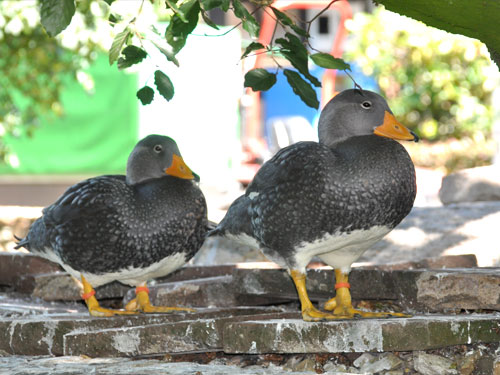Fuegian Steamer Duck

Scientific Name
Tachyeres pteneres
Alternative Names
Fuegian steamer duck, Magellanic steamer duck
Measurements
| Measurement | Male | Female |
|---|---|---|
| Length | 65–84 cm (26–33 in) | Slightly smaller |
| Weight | 3.5–7 kg (7.7–15.4 lb), average 5.34 kg (11.8 lb) | Around 4.2 kg (9.3 lb) |
| Wingspan | 85–110 cm (33–43 in), flightless | Slightly smaller |
Status / Origin
Native to southern Chile, Chiloé, and Tierra del Fuego. A flightless marine duck, it lives mainly along rocky coasts and coastal islands. Moves to calm bays and inland lakes during the breeding season.
Identification
The largest steamer duck. Strong, heavy body with small wings used for paddling, not flying. Males have blue-grey heads and necks, pale foreheads, a narrow white eye-ring, and a reddish-brown throat. Their underparts are white with grey tails. Females are darker grey-brown with a reddish throat and may show brown or wine-colored feathers. Juveniles look like females but are duller.
Voice
Generally quiet but during breeding season, males make low grunts and harsh calls when defending territory.
Diet
Feeds mainly on saltwater mollusks, crustaceans, small fish, snails, insect larvae, amphipods, and isopods. Dives or upends in shallow water to find food. Uses a salt gland above the eyes to remove excess salt.
Distribution
Chile, Chiloé Island, Tierra del Fuego, and nearby coastal regions of Argentina.
Habitat
Rocky sea coasts, offshore islands, sheltered bays, and inland lakes during breeding.
Breeding
Breeds from September to December. Nests in dense vegetation near water or in abandoned penguin burrows. Lays 4–11 ivory eggs, average 9. Eggs are about 8.2 × 5.6 cm and weigh around 167 g. Incubation lasts 28–40 days. Young fledge at 120–130 days and are then driven away to form flocks. They become fully mature at 2–3 years.
Wintering
Non-migratory. Stays in its home range year-round.
Threats
Eggs and ducklings are preyed on by foxes, caracaras, gulls, skuas, petrels, and sometimes marine otters. Adults have few predators, except sea lions.
Conservation
Not globally threatened. Most numerous of all steamer ducks. Known for extremely aggressive behavior; males may kill other waterbirds, even larger ones, especially during breeding season. Needs isolated enclosures in captivity due to aggression.
